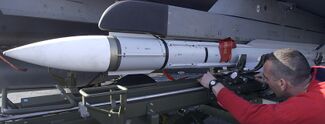M-13 MSRA
| M-13 MSRA | |
|---|---|
 A MSRA being fitted to the wing of an EF-135 Draken | |
| Type | Active radar guided air-to-air missile and surface-to-air missile |
| Place of origin | |
| Service history | |
| In service | 2008-Present |
| Used by | Acrea |
| Wars | Zemplen War |
| Production history | |
| Designer | NordEX Försvarssystemet AB |
| Manufacturer | NordEX Försvarssystemet AB |
| Specifications | |
| Weight | 160 kg (350 lb) |
| Length | 3.4 m (11 ft 2 in) |
| Diameter | 160 mm (6.3 in) |
| Effective firing range |
|
| Warhead | High explosive blast-fragmentation |
Detonation mechanism | Proximity or direct impact fuse |
| Engine | Solid-propellant rocket motor |
| Speed | Mach 4 |
Guidance system |
|
The M-13 MSRA (Missil, strids, radar-activ), often called the "Misrah", is an active radar guided air-to-air missile and surface-to-air missile designed and manufactured by Kobalt-Zeiss AG and NordEX Försvarssystemet AB. The missile was designed to achieve the long range, multi-target capability of the previous M-10C DRAAM missiles, while utilising a smaller missile with very high kinematic performance. It was designed in tandem with the M-9 IRSS infrared missile for use with the EF-633 Mako and EF-662 Vampyr fighters, as well as to equip the EF-135 Draken with more capable armament. The missile has an operational range exceeding 100 km, or approximately 54 nm.
Design
Propulsion
The MSRA uses a solid-propellant rocket motor for propulsion. Prototypes included an air-augmented ducted rocket, but subsequent testing found the missile to be too heavy, too large, and lacking in late-stage speed compared to more advanced solid-propellant rockets being developed at the time. Thus, much development in propulsion went into providing for a longer-ranged rocket motor to provide with a higher speed at the end of its flight, at the cost of a lower average speed when fired at extreme ranges.
The defining feature of the MSRA is its use of thrust vectoring control. Adopted from development of the M-9 IRSS, thrust vectoring was added to better utilise the TWS guidance features that new AESA radars being designed into the EF-633 and EF-662, and which were being upgraded into the EF-135, were capable of. Focus went into ensuring that the MSRA was able to retain energy as it closed to the target, which in combination with the thrust vector control provides significantly improved performance against hard-maneuvering targets compared to other contemporary radar-guided missiles. This was done to take advantage of the widespread use of AESA radars among Acrean aircraft, which allows for missiles fired while the radar is in TWS to be more accurate and effective than aircraft lacking such radars. The kinematic performance and energy retention of the MSRA was designed to take advantage of this capability, particularly when utilised by 5th generation fighters.
Control
Being designed with the sensor fusion and data link capabilities of EFX-series fighters in mind, the MSRA has extensive functionality via datalink in addition to its own inertial navigation system. The use of the MSSL data link allows the aircraft to receive mid-course updates to its flight path as well as be redirected to a new target while in flight. Guidance of the missile can be passed off to other aircraft mid-flight using the datalink, and with this method it can also be targeted onto radar contacts obtained by another aircraft even if the launching aircraft itself does not have a radar lock. Terminal guidance is provided by the missile's onboard radar, and when fired in TWS the missile will go pitbull at approximately 9to 11 nm.
Warhead
Variants
- M-13A MSRA - Model with improvements to control surfaces, retrofitted to all missiles in late 2010
- M-13C MSRA - Model with improved onboard radar, inertial navigation system, and rocket motor adopted in 2016